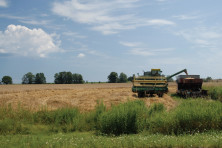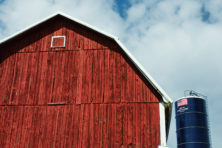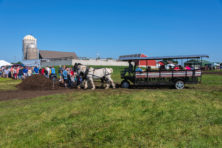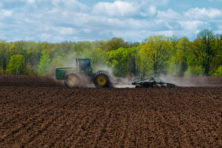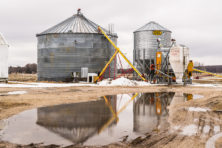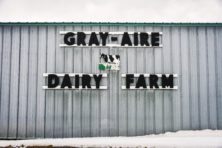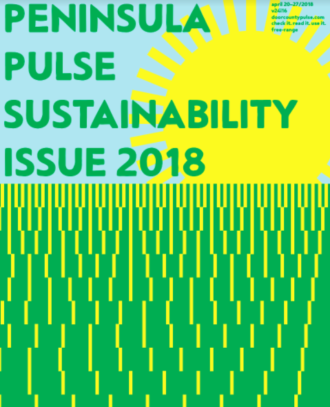
In this issue of Sustainability we look at the future of farming the peninsula, but first let’s take a quick look at where we’ve been and where we are going.
In 1915 – a mere century ago – there were 25.5 million horses and mules on American farms and some 39 million acres were devoted to oats to feed them.
Twenty years later, in 1945, the industrial revolution had finally taken over in agriculture. That is the year tractor power exceeded equine power. Not that the number of tractors and horses was equal. It is generally recognized that a tractor can do the work of five draft animals.
“It’s so much more efficient now with the changes in equipment,” said fourth generation Jacksonport farmer Randy Halstead.
As an example he mentions the stone picking that always was required after using a traditional plow on a field. The shape of the plow brought stones to the surface that had to be removed.
Halstead noted that another farmer was using a German-made plowing disc that did not bring stones up.
“Sometimes you steal ideas from other farmers,” Halstead said.
He bought a similar German plowing disc four years ago.

“The way it’s set up with the pitch and the angle and the speed you go, it does a really nice job of preparing the seed bed,” he said. “You’ve got to be open to new ideas. You can’t live in the past.”
Smart farming is essential as the world continues to grow and the world’s arable land decreases. The Food and Agriculture Organization of the United Nations predicts that 9.6 billion people will need to be fed daily by 2050, which means food production must increase by 70 percent.
Precision agriculture is one answer. It seeks to optimize returns while preserving resources. The advent of Global Positioning System allows farmers and researchers to measure as many variables as possible – terrain features, organic matter content, moisture levels, crop yield. Crop science and soil health are key components of precision ag’s success.
Precision agriculture is considered the third wave of modern agricultural movements – the first being the mechanization of the early 20th century, when a single farmer produced food for approximately 26 people. The second wave is identified as the green revolution of the 1990s, with each farmer feeding approximately 155 people.
With this third wave of precision or smart farming, each farmer will be expected to feed 265 people on the same acreage as his predecessors.
Some have suggested that good soil should be put on an endangered list. One of the key research areas for the future of farming may be understanding the microbes in the dirt. Ninety percent of the world’s organisms live underground, many of which contribute to soil health. No-till farming and planting of cover crops are gaining wider currency among farmers as ways to improve soil health.
Researchers such as Professor Sharon Doty in the School of Environmental and Forest Sciences at the University of Washington has been investigating possible green solutions to environmental problems through plant-microbe partnerships. The idea is to improve plant growth with less water and chemicals, while removing environmental pollutants.
Doty has been studying the effect of endophytes of poplar and willow, trees that grow in low-nutrient, hostile environments. Endophytes are microbes (fungi and bacteria) that exist in living plant cells.
Testing endophytes on a variety of grasses, grains, vegetables and other trees, Doty and her team have learned that endophytes promote plant growth – 60 percent more root biomass and 48 percent more shoot biomass – even in nutrient-deficient soil. Plants colonized by endophytes are also able to withstand drought better than normally produced plants. The endophytes fix nitrogen, produce plant hormones, solubilize phosphate and increase drought tolerance.
So what does this mean for the future of farming? What it comes down to is that our current understanding of nature is based on what we know to date, and there are important discoveries to be made.
In this issue
-
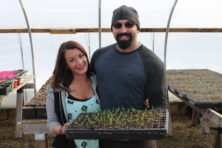
Small Farm Succession: Two Locals Start Their Dream Farm
For weeks on the commute into Sturgeon Bay along County S, Jake VandenPlas would see a “For Sale” sign at the corner of Vignes Road in front of two greenhouses. A hobbyist with a few small gardens to his name, VandenPlas wondered about the possibilities that would come with these two large greenhouses. “I wanted […]
-
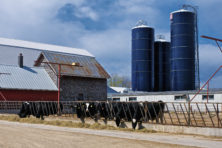
In 2017, the National Young Farmers Coalition received 3,517 responses to a survey from past, current and aspiring farmers about their take on the agricultural industry. Farmers up to 40-years-old cite many challenges in agriculture, but also take a diverse approach to the ever-changing industry. 1 Access to affordable farmland is the top concern for […]
-
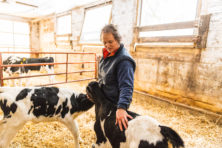
Females May Reign in Future of Farming
The days of the man working hard on the farm while his wife prepares supper may not be gone, but they may be on the way out. A proliferation of women in the agriculture industry, particularly dominating collegiate agricultural classrooms, is leading a shift in what has traditionally been a male-centric field. At University of […]
-
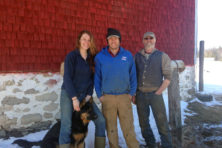
Bryan Haberli: Farming is Sustainable with Smart Practices
Last September when the county Land Conservation Committee met to discuss changes to NR 151, the state’s manure-handling rule, in northeastern Wisconsin’s karst region, Egg Harbor farmer Bryan Haberli was one of those to speak against the change that would prevent manure from being spread on soils of less than two feet. He agreed that […]
-

Commentary: Dairy Farms Rely on Immigrant Labor
By Luca Fagundes The debate about immigration in America has been centered on a border wall ever since Donald Trump made it an issue in his presidential campaign. The reality is that the debate is about something far more important. In Wisconsin, it’s about food, and more specifically, dairy. The Wisconsin dairy industry relies heavily […]
-

By the Numbers: Agriculture in Wisconsin
1 While Wisconsin remains America’s Dairyland, it is first in these products: snap beans for processing; cranberries; ginseng; mink pelts; dry whey for humans; milk goats; corn silage; specialty cheese; and exported bovine semen. 3 Wisconsin’s ranking as a potato-producing state. There were 64,000 acres of potatoes planted in the state in 2016. 5 Wisconsin’s […]
-
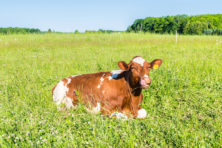
Future of Farming With DATCP Secretary Shelia Harsdorf
Wisconsin history was made last November when state Senator Sheila Harsdorf was tapped by Gov. Scott Walker to be the first woman to head the state Department of Agriculture, Trade and Consumer Protection. She had served the 10th Senate District in northwestern Wisconsin from 2001 until being named the department head. Before that, she represented […]

